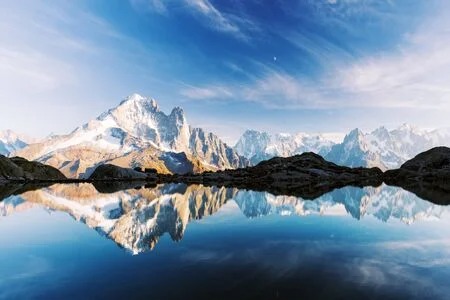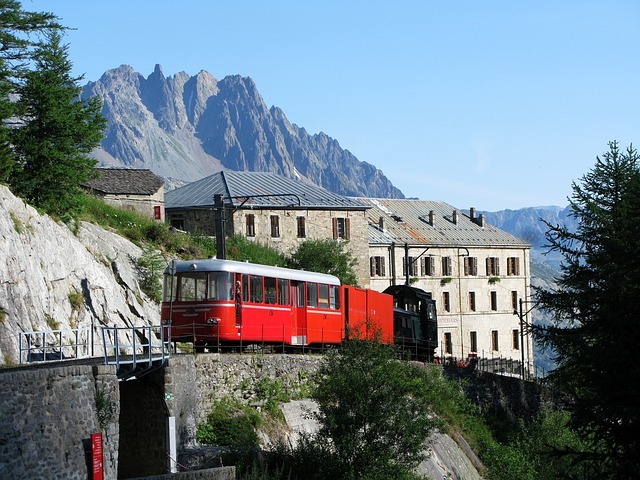
As the Chamonix valley’s glaciers continue to shrink due to the climate crisis, tourist guides and their clients are finding ways to adapt and assist.
The Glacier du Tour is perched atop the mountain, resembling a frozen cresting wave that has stood still in time. As I listen to the joyful sounds of skiers swishing through slush and the laughter and shrieks of beginners on the La Vormaine slopes, I gaze at the glacier’s jagged blocks of ice and bluish hue, while mourning the extent to which it has receded since I resided in this area 23 years ago.
The Mont Blanc massif is among the most heavily glaciated regions in the Alps, with glaciers visible from nearly every viewpoint in the Chamonix valley, including all four primary ski areas in town: Le Brévent, La Flégère, Grands Montets, and Le Tour (which encompasses La Vormaine’s beginner slopes).
Chamonix’s tourism industry has revolved around the high-mountain surroundings of its glaciers since the late 1800s. The impressive Glacier des Bossons, resembling a frozen waterfall that cascades between Mont Blanc and France’s highest cable car, the Aiguille du Midi, offers the most exceptional vantage point, with much of the town designed to showcase it. The Mer de Glace, the second longest glacier in the Alps, accessed via the Montenvers train or skiing and snowboarding down the off-piste Vallée Blanche, remains one of the area’s top tourist attractions.
Starting next year, a glacier and climate interpretation center will be established on the Mer de Glace to confront the apparent danger that these majestic, slow-moving ice bodies are encountering due to global warming. Local glaciologist Luc Moreau, who has studied Chamonix’s glaciers since 1987, informs me that every glacier in the valley has substantially melted since the 1990s. His simulations indicate that by the conclusion of this century, with the Alps warming at a rate exceeding the global average, all glaciers under 3,500 meters will have vanished, while the highest lift ends at 3,842 meters.
As long as they remain, the glaciers serve as a dynamic laboratory where people can directly observe the consequences of global warming and, according to Luc, potentially become motivated to take action. “They expose what is usually hidden,” says Luc, who welcomed President Emmanuel Macron to the Mer de Glace in 2020 and sent a letter to him in January requesting prompt intervention.
Ski resorts have traditionally avoided extensive discussions about the climate crisis, aside from highlighting new environmentally friendly hotels and snowmaking systems, to avoid deterring potential vacationers or diminishing the experience for those who have already arrived. However, in 2021, the Compagnie des Guides de Chamonix, the world’s oldest and largest association of mountain guides, chose to tackle the issue head-on and make environmental stewardship a part of its mandate, in honor of its 200th anniversary.
To gain further insight, I accompany Brad Carlson, a high-mountain guide and ecologist who has resided and worked in the region for over a decade, on a half-day splitboarding excursion (utilizing a snowboard that splits into two to serve as touring skis).
Our ascent commences with the highest lift at La Flégère, before veering left to savor awe-inspiring vistas of the Mer de Glace and Glacier d’Argentière on the opposite side of the valley, while the jagged summits of the Mont Blanc Massif tower above them. Despite it being early February, the climate is balmy, bright, and reminiscent of spring.
According to Brad, mountain guides would previously only discuss the environmental shifts they observed in an unofficial capacity. “It was a forbidden topic,” he discloses. However, he now reports that roughly three-quarters of his clients initiate dialogue on the subject.
While making our way up towards the Col du Belvédère, we observe numerous groups of ski tourers accompanied by guides, ranging from early 20s to early 60s. Brad shares his perspective, “Some individuals might assume that visiting this area will expose them to sights of decay, but in reality, it remains just as stunning as ever.” I wholeheartedly concur. “Mountain ecosystems are constantly evolving, and guides have had to adjust in the past,” he adds.
“The aim is to shift the mindset of clients from having rigid goals like climbing a specific mountain or skiing fresh powder, to being more adaptable and open to the current conditions,” says Brad. He explains that guides are encouraging guests to ask questions like, “What makes sense right now?” instead of having a fixed plan. With the snow season getting shorter, some guides are exploring activities that don’t depend on snow, such as canyoning and rafting. The ultimate goal is to rebuild people’s expectations of what the Alps can offer and promote a more flexible approach.

My husband and I decided to take the Montenvers train to the Mer de Glace on another day. It was a disorienting experience for me, as when I last snowboarded in the area back in 2001, there were only 118 steps from the glacier to the cable car. But now, we had to go down 580 steps due to the glacier’s retreat. Each year, additional steps have been added to make up for the disappearing ice.
Construction has already commenced on a lift to substitute the steps, and the Glaciorium interpretation centre is set to open its doors next year. Through interactive displays, it will illustrate the transformation of glaciers and our association with them. The objective is to conserve and elevate the memory of this pioneering location and simultaneously enlighten visitors about the consequences of the climate emergency on the valley.
According to Zoe Hart, a high-mountain guide who has resided in the area for over two decades, merely discussing the situation with guests is insufficient.
Although such visits may be an instrument in environmental awareness, she asserts, it is insufficient to merely educate visitors about the situation, allow them to feel disheartened, and then return home to disregard the issue. Instead, while tourists are present, concrete measures should be taken to safeguard this resource.
Zoe recommends her clients to support environmental non-profits by making contributions, whereas Brad proposes supporting the Alpine ecosystem research centre, CREA, and participating in citizen science projects developed by the CREA team. Brad anticipates that these initiatives will eventually be integrated into guided tours with clients.
The two main concerns that are often overlooked are the environmental impact of tourism in this delicate ecosystem and the carbon emissions resulting from travel. We made the journey in a hybrid car with a group of four, which is a better option than flying but not as eco-friendly as taking the train, especially during peak travel periods such as the February school holidays.
Chamonix relies on hydroelectric power to run much of its resort operations, and some of the power is generated from the valley’s glacier meltwater. However, the resort still uses snow groomers that emit CO2, although the lift company is trying to reduce emissions by experimenting with hybrid machines and zero-emission HVO (hydrotreated vegetable oil) fuel. The lift company aims to become carbon-neutral within a decade, and it is currently working on a biogas plant project. Furthermore, many buses and trains in the valley are hybrid, and some buses run on natural gas. Ski lift pass holders can also use buses and trains for free during the winter season.
Zoe doesn’t believe that the solution is to shame people into not visiting the area. After all, hiring mountain guides does contribute to the local economy. However, she does advocate for a tourist tax. “People who visit Chamonix spend a considerable amount of money on accommodation, lift passes, dining, and transportation: they can afford to allocate 1% of that towards a good cause,” she says.
As the week draws to a close, we make our way to the impressive Glacier d’Argentière on skis and snowboards with my son and his friends, and their reaction is far from gloomy – they let out a series of gasps and wows. Although most 13-year-olds are aware of the potential consequences of the climate crisis, it doesn’t stop them from enjoying the present and admiring the distinctive and delicate high-mountain surroundings.
Chamonix-Mont-Blanc Tourist Office offers guided splitboard/ski tours starting from €105 per person. For splitboard rental, Zero G charges €70 per day. Ski touring equipment is available for rent at Intersport in Chamonix for €50 per day.



